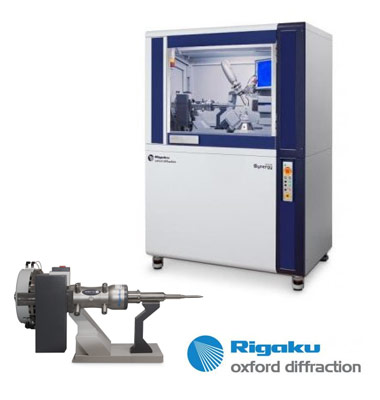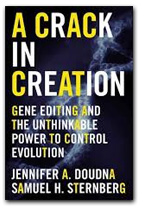|
The End of an Era

August 31, 2017 marked the end of an era, with the retirement of Paul Swepston (Ph.D. 1981, University of Arkansas under Wally Cordes) from Rigaku. Paul???s career with Rigaku and its previous incarnations, Molecular Structure Corporation and Rigaku/MSC, spanned four decades. During that time, he was instrumental in the evolution of crystallographic hardware and software.
Paul joined Molecular Structure Corporation in the early 1980s. Although MSC had started representing crystallographic hardware with a now-defunct manufacturer, it was primarily a crystallographic contract research organization. In 1984, MSC began a marketing and sales relationship for Rigaku single crystal diffractometers in North America. As Vice President in charge of software development, Paul saw the potential for these instruments and spearheaded an initiative to create the world???s first fully automatic data collection software.
All crystallographers of a certain age know how different the science is now compared to when Paul started with MSC. Data collection took days, even weeks, and, before Paul and his team automated the software, user intervention was required at every step of the operation, which meant that the diffractometer often sat idle awaiting instructions. Paul was instrumental in ensuring that users were able to maximize usage of this valuable investment by building in expert knowledge at important decision-making steps during the data collection process, something taken for granted these days.
In parallel, he worked on a fully integrated structure solution and refinement program called TEXSAN that would be used by crystallographers around the world. Prior to TEXSAN, most crystallographers had to be amateur programmers as well, to convert the output from one standalone program into a format that could be used by another. Crystallographers also had to become familiar with the idiosyncratic command sets for a variety of programs. TEXSAN removed these necessities, providing users with a common, easy-to-use interface that did all of the messy format conversion work behind the scenes. Paul also arranged licensing agreements with software developers around the world to provide a massive structure solution toolkit for crystallographers. Everyone had a favorite direct methods program, so why not support them all?
TEXSAN led to teXsan, the first UNIX version of the software, which was storyboarded on a train from Bordeaux to Paris after the IUCr meeting in 1990. Large, mainframe computers were giving way to smaller workstations and ultimately to personal computers. Paul and his group liberated diffractometers from expensive, bulky control computers when MSC ported the MSC/AFC diffractometer control software, which could run on virtually any IBM compatible PC. This was followed by teXsan for Windows, a project Paul also managed, which meant crystallographers could solve and refine structures from the comfort of their desktop computers instead of in a chilly computer lab.
During his years at Rigaku, Paul held various positions of leadership. In his most recent position, as Global Manager of Rigaku Oxford Diffraction, Paul oversaw the merger of the Agilent XRD group with Rigaku to form Rigaku Oxford Diffraction and development of the newest generation of single crystal diffractometers, the Synergy series. With innovative X-ray sources and area detectors, it is now possible to determine the structure of a molecule for identification purposes in mere minutes, a process that took weeks at the beginning of Paul???s crystallographic career.
Paul???s legacy at Rigaku will be felt far into the future. We all wish Paul the best for his retirement!
Crystallography
in the news
September 1, 2017. A team of scientists at Arizona State University has taken us a step closer to unlocking the secrets of photosynthesis, and possibly to cleaner fuels. Their discovery describes the structure of a reaction center (from a heliobacterium) that preserves the characteristics of the ancestral one, and so provides new insight into the evolution of photosynthesis.
September 4, 2017. Scientists have discovered the details of an unconventional coupling between a bacterial protein and a mineral that allows the bacterium to breathe when oxygen is not available.
The research, conducted by a team of scientists at the Department of Energy's Lawrence Berkeley National Laboratory (Berkeley Lab), could lead to new innovations in linking proteins to other materials for bio-based electronic devices.
September 11, 2017. Chiral nanomaterials have received wide interest in many areas, but the exact origin of chirality at the atomic level remains elusive in many cases. With recent significant progress in atomically precise gold nanoclusters (e.g., thiolate-protected Aun(SR)m), several origins of chirality have been unveiled based upon atomic structures determined by using single-crystal X-ray crystallography.
September 13, 2017. Duke researchers have discovered a new way to inhibit the infectious bacteria Francisella tularensis, infamous for its potential as a bioweapon. The team of biochemists uncovered that the organism becomes virulent through its unusual interactions with proteins. Left unchecked, the bacterium can cause the disease tularemia, which can prove fatal if not immediately treated.
September 15, 2017. The world???s most powerful X-ray laser, the European X-ray Free Electron Laser, has blasted its first sample. Firing pulses more than a trillion times more intense than sunlight, and often obliterating anything it touches, the XFEL may sound like a supervillain???s death ray.
September 19, 2017. Two Caltech postdoctoral scholars have been named fellows of the Hanna H. Gray Fellows Program through the Howard Hughes Medical Institute (HHMI). The program aims to increase diversity in the biomedical research community by providing postdoctoral and early career funding to emerging scientists in the life sciences.
September 20, 2017. A team of Osaka University researchers has designed a novel antibody fragment with improved production compatibility, stability and crystallizability, while maintaining the binding ability of the original molecule. Such fragments have found use as crystallization chaperones to aid in the structural determination of otherwise "uncrystallizable" or "undruggable" target proteins.
September 20, 2017. Richard Henderson, a group leader and scientist emeritus in the Division of Structural Studies at the U.K. Medical Research Council Laboratory of Molecular Biology (MRC LMB), presented the 2017-18 Ernest C. Pollard Lecture on September 28 at the Penn State University Park campus.
Product spotlight: XtaLAB Synergy-DW
One source with two high-flux wavelengths is the foundation of the revolutionary XtaLAB Synergy-DW diffractometer. It combines the increased flux of a rotating anode source with the flexibility of two different wavelengths, making it ideal for laboratories exploring a wide range of crystallographic research interests.
The XtaLAB Synergy-DW is based on the proven, low-maintenance MicroMax-007 HF microfocus rotating anode. The target is constructed with two different source materials (Cu and Mo) and is coupled with an auto-switching dual wavelength optic. Copper or molybdenum X-ray radiation is available at the click of a button. The XtaLAB Synergy-DW offers up to 12x higher flux compared to the standard sealed tube sources and, utilizing only one generator, means overall maintenance is reduced.
Rounding out the XtaLAB Synergy-DW configuration is the fast and efficient four-circle kappa goniometer which is compatible with a wide range of detectors including the HyPix-6000HE and other Hybrid Photon Counting (HPC) detectors e.g. PILATUS and EIGER detectors.
Features:
- Access to two wavelengths in one compact system
- 12x higher flux than sealed tube X-ray sources
- Low maintenance, high performance system
- Uses CrysAlisPro software with both PX and SMX modes
Benefits:
- Multi-functional diffractometer to cover you wherever
your research takes you
- High flux performance means you all your crystallography
needs can be carried out 'in-house'
- Very little downtime and easy maintenance
- No need to purchase extra software for different applications

For more about XtaLAB Synergy-DW.
Lab in the spotlight
 Prof. Joel L. Sussman
Prof. Joel L. Sussman
Department of Structural Biology
Weizmann Institute of Science
For more than thirty years, Professor Joel Sussman has worked closely with Professor Israel Silman, of the Neurobiology Department, studying proteins involved in neural transmission via cholinergic mechanisms. Their work has focused on the studies of the synaptic enzyme acetylcholinesterase (AChE), whose principal role is termination of synaptic transmission at cholinergic synapses by rapid hydrolysis of the neurotransmitter, acetylcholine. For over 50 years, AChE has been the subject of intense interest for enzymologists, pharmacologists and toxicologists due to its extremely high catalytic activity, a requirement for its biological activity, and since it is the target of the first generation of anti-Alzheimer (AD) drugs and of potent nerve agents and insecticides.
From the onset, their joint objective was the determination of the 3D structure of AChE so as to understand its mechanism of action and permit structure-based drug design. Although attempts started in the 1960s, no crystals suitable for 3D structure determination were obtained prior to their pioneering work. They developed a novel, mild approach to solubilization of membrane-bound AChE from Torpedo californica electric organ (TcAChE), followed by its crystallization, and then by the solution of its 3D structure. Their publication of the structure, as a full paper in Science, has been cited over 2,450 times, and many ensuing papers hundreds of times. They subsequently solved and published two additional important AChE structures, those of human and Drosophila AChE. Concomitantly, they have solved the structures of more than 40 complexes and conjugates of AChE with a broad repertoire of drugs, toxins and other ligands. Those include essentially all the first-generation anti-AD drugs, several of the major nerve agents, insecticides, transition-state analogs and a snake venom toxin. Those structural data provide an essential reservoir of information for generation of novel lead drugs. They have published over 170 joint papers.
In addition, Professor Sussman has helped to create and continues to develop:
Useful link
 2017 publication guidelines for structural modelling of small-angle scattering data from biomolecules in
solution: an update
2017 publication guidelines for structural modelling of small-angle scattering data from biomolecules in
solution: an update
Selected recent crystallographic papers
After Fifty Years, Why Are Protein X-ray Crystallographers Still in Business? Mitchell, Sandra D.; Gronenborn, Angela M. British Journal for the Philosophy of Science. Sep2017, Vol. 68 Issue 3, p703-723. 21p. DOI: 10.1093/bjps/axv051.
New cyrhetrenyl and ferrocenyl sulfonamides: Synthesis, characterization, X-ray crystallography, theoretical study and anti-Mycobacterium tuberculosis activity. Quintana, Cristóbal; Silva, Gisella; Klahn, A. Hugo; Artigas, Vania; Fuentealba, Mauricio; Biot, Christophe; Halloum, Iman; Kremer, Laurent; Novoa, Néstor; Arancibia, Rodrigo. Polyhedron. Sep2017, Vol. 134, p166-172. 7p. DOI: 10.1016/j.poly.2017.06.015.
Synthesis of a new pyridinyl thiazole ligand with hydrazone moiety and its cobalt(III) complex: X-ray crystallography, in vitro evaluation of antibacterial activity. Bera, Pradip; Brandão, Paula; Mondal, Gopinath; Jana, Harekrishna; Jana, Abhimanyu; Santra, Ananyakumari; Bera, Pulakesh. Polyhedron. Sep2017, Vol. 134, p230-237. 8p. DOI: 10.1016/j.poly.2017.06.024.
Recent advances in racemic protein crystallography. Yan, Bingjia; Ye, Linzhi; Xu, Weiliang; Liu, Lei. Bioorganic & Medicinal Chemistry. Sep2017, Vol. 25 Issue 18, p4953-4965. 13p. DOI: 10.1016/j.bmc.2017.05.020.
The Conformational Flexibility of the Acyltransferase from the Disorazole Polyketide Synthase Is Revealed by an X-ray Free-Electron Laser Using a Room-Temperature Sample Delivery Method for Serial Crystallography. Mathews, Irimpan I.; Allison, Kim; Robbins, Thomas; Lyubimov, Artem Y.; Uervirojnangkoorn, Monarin; Brunger, Axel T.; Khosla, Chaitan; DeMirci, Hasan; McPhillips, Scott E.; Hollenbeck, Michael; Soltis, Michael; Cohen, Aina E. Biochemistry. 9/12/2017, Vol. 56 Issue 36, p4751-4756. 6p. DOI: 10.1021/acs.biochem.7b00711.
Mannobiose Binding Induces Changes in Hydrogen Bonding and Protonation States of Acidic Residues in Concanavalin A As Revealed by Neutron Crystallography. Gerlits, Oksana O.; Coates, Leighton; Woods, Robert J.; Kovalevsky, Andrey. Biochemistry. 9/12/2017, Vol. 56 Issue 36, p4747-4750. 4p. DOI: 10.1021/acs.biochem.7b00654.
Covalent inhibitors for eradication of drug-resistant HIV-1 reverse transcriptase: From design to protein crystallography. Chan, Albert H.; Won-Gil Lee; Spasov, Krasimir A.; Cisneros, José A.; Kudalkar, Shalley N.; Petrova, Zaritza O.; Buckingham, Amanda B.; Anderson, Karen S.; Jorgensen, William L. Proceedings of the National Academy of Sciences of the United States of America. 9/5/2017, Vol. 114 Issue 36, p9725-9730. 6p. DOI: 10.1073/pnas.1711463114.
1,3-Oxazole-based selective picomolar inhibitors of cytosolic human carbonic anhydrase II alleviate ocular hypertension in rabbits: Potency is supported by X-ray crystallography of two leads. Ferraroni, Marta; Lucarini, Laura; Masini, Emanuela; Korsakov, Mikhail; Scozzafava, Andrea; Supuran, Claudiu T.; Krasavin, Mikhail. Bioorganic & Medicinal Chemistry. Sep2017, Vol. 25 Issue 17, p4560-4565. 6p. DOI: 10.1016/j.bmc.2017.06.054.
A Bright Future for Serial Femtosecond Crystallography with XFELs. Johansson, Linda C.; Stauch, Benjamin; Ishchenko, Andrii; Cherezov, Vadim. Trends in Biochemical Sciences. Sep2017, Vol. 42 Issue 9, p749-762. 14p. DOI: 10.1016/j.tibs.2017.06.007.
Microstructures, crystallography and geochemistry of magnetite in 2500 to 2200 million-year-old banded iron formations from South Africa, Western Australia and North China. Sun, Si; Li, Yi-Liang. Precambrian Research. Sep2017, Vol. 298, p292-305. 14p. DOI: 10.1016/j.precamres.2017.06.015.
Intact Protein Analysis at 21 Tesla and X-Ray Crystallography Define Structural Differences in Single Amino Acid Variants of Human Mitochondrial Branched-Chain Amino Acid Aminotransferase 2 (BCAT2). Anderson, Lissa; Håkansson, Maria; Walse, Björn; Nilsson, Carol. Journal of the American Society for Mass Spectrometry. Sep2017, Vol. 28 Issue 9, p1796-1804. 9p. DOI: 10.1007/s13361-017-1705-0.
Nanosecond pump-probe device for time-resolved serial femtosecond crystallography developed at SACLA. Kubo, Minoru; Nango, Eriko; Tono, Kensuke; Kimura, Tetsunari; Owada, Shigeki; Song, Changyong; Mafuné, Fumitaka; Miyajima, Ken; Takeda, Yoshihiro; Kohno, Jun-ya; Miyauchi, Naoya; Nakane, Takanori; Tanaka, Tomoyuki; Nomura, Takashi; Davidsson, Jan; Tanaka, Rie; Murata, Michio; Kameshima, Takashi; Hatsui, Takaki; Joti, Yasumasa. Journal of Synchrotron Radiation. Sep2017, Vol. 24 Issue 5, p1086-1091. 5p. DOI: 10.1107/S160057751701030X.
Watching proteins function with time-resolved x-ray crystallography. Vukica ??rajer; Marius Schmidt. Journal of Physics: D Applied Physics. 9/20/2017, Vol. 50 Issue 37, p1-1. 1p. DOI: 10.1088/1361-6463/aa7d32.
From Macrocrystals to Microcrystals: A Strategy for Membrane Protein Serial Crystallography. Dods, Robert; Båth, Petra; Arnlund, David; Beyerlein, Kenneth R.; Nelson, Garrett; Liang, Mengling; Harimoorthy, Rajiv; Berntsen, Peter; Malmerberg, Erik; Johansson, Linda; Andersson, Rebecka; Bosman, Robert; Carbajo, Sergio; Claesson, Elin; Conrad, Chelsie E.; Dahl, Peter; Hammarin, Greger; Hunter, Mark S.; Li, Chufeng; Lisova, Stella. Structure. Sep2017, Vol. 25 Issue 9, p1461-1468.e2. 1p. DOI: 10.1016/j.str.2017.07.002.
cis-Protected palladium(II) based binuclear complexes as tectons in crystal engineering and the imperative role of the cis-protecting agent. Krishnaswamy, Shobhana; Chand, Dillip Kumar. CrystEngComm. 9/21/2017, Vol. 19 Issue 35, p5157-5172. 16p. DOI: 10.1039/c7ce00654c.
A highly crystalline oriented metal–organic framework thin film with an inorganic pillar. Watanabe, Yuki; Haraguchi, Tomoyuki; Otsubo, Kazuya; Sakata, Osami; Fujiwara, Akihiko; Kitagawa, Hiroshi. Chemical Communications. 9/18/2017, Vol. 53 Issue 73, p10112-10115. 4p. DOI: 10.1039/c7cc03828c.
Symmetry Influence on the Rotation of Molecules in Crystals. Islamov, Daut R.; Shtyrlin, Valery G.; Serov, Nikita Yu.; Fedyanin, Ivan V.; Lyssenko, Konstantin A. Crystal Growth & Design. Sep2017, Vol. 17 Issue 9, p4703-4709. 7p. DOI: 10.1021/acs.cgd.7b00588.
Predicting the Nucleation Induction Time Based on Preferred Intermolecular Interactions. Patel, Mitulkumar A.; Nguyen, Brittany; Chadwick, Keith. Crystal Growth & Design. Sep2017, Vol. 17 Issue 9, p4613-4621. 9p. DOI: 10.1021/acs.cgd.7b00446.
Forty Years of Sodium Channels: Structure, Function, Pharmacology, and Epilepsy. Catterall, William. Neurochemical Research. Sep2017, Vol. 42 Issue 9, p2495-2504. 10p. DOI: 10.1007/s11064-017-2314-9.
A review on synthesis, crystal structure and functionality of naphthalenedicarboxylate ligated metal-organic frameworks. Gangu, Kranthi Kumar; Maddila, Suresh; Jonnalagadda, Sreekantha B. Inorganica Chimica Acta. Sep2017, Vol. 466, p308-323. 16p. DOI: 10.1016/j.ica.2017.06.038.
Real-time detection and resolution of atom bumping in crystallographic models. Liu, Yu. Acta Crystallographica. Section A, Foundations & Advances. Sep2017, Vol. 73 Issue 5, p414-422. 8p. DOI: 10.1107/S2053273317011548.
Protein structure estimation from NMR data by matrix completion. Li, Zhicheng; Li, Yang; Lei, Qiang; Zhao, Qing. European Biophysics Journal. Sep2017, Vol. 46 Issue 6, p525-532. 8p. DOI: 10.1007/s00249-017-1198-6.
Proceedings of the 15th European Powder Diffraction Conference. Brunelli, Michela; Scardi, Paolo; Altomare, Angela. Powder Diffraction. Sep2017 Supplement1, Vol. 32, pS1-S1. 1p. DOI: 10.1017/S0885715617000653.
Book review
A Crack in Creation: Gene Editing and the Unthinkable Power to Control Evolution: Jennifer Doudna and Samuel H. Sternberg, Houghton Mifflin Harcourt, New York, 2017, 282 pp., ISBN-13: 978-0544716940
 CRISPR is one of the hottest buzzwords in the biotech world right now. The ability to edit genes directly in living things – plants, animals, and even, maybe one day soon, humans – is here. Jennifer Doudna is one of CRISPR's foremost pioneers. In her lab at Berkeley, she helped start the CRISPR revolution. Samuel Sternberg is one of her fellow researchers and co-author. Their book (according to the jacket cover, a favorite of Star Wars' creator George Lucas) reads a bit like "CRISPR for Dummies" – but in the best possible way.
CRISPR is one of the hottest buzzwords in the biotech world right now. The ability to edit genes directly in living things – plants, animals, and even, maybe one day soon, humans – is here. Jennifer Doudna is one of CRISPR's foremost pioneers. In her lab at Berkeley, she helped start the CRISPR revolution. Samuel Sternberg is one of her fellow researchers and co-author. Their book (according to the jacket cover, a favorite of Star Wars' creator George Lucas) reads a bit like "CRISPR for Dummies" – but in the best possible way.
Doudna and Sternberg break down CRISPR, which stands for Clustered Regularly Interspaced Short Palindromic Repeats, into plain, simple English. Even someone without a strong science background could probably understand the basic principle behind CRISPR. It allows scientists to edit DNA: remove bad genes or add good ones. It can help us make cows more muscular so that more meat comes from each animal, or make plants less susceptible to fungal outbreaks.
The most interesting part of Doudna and Sternberg's book isn't the specifics of CRISPR and how it works; it is the dissection of the ethical and moral implications of direct germline editing. They detail the obvious potential pitfalls of the process – like eugenics – and even describe a Chinese experiment where attempts were made to edit the germline in embryos – an experiment that failed.
CRISPR represents a tremendous breakthrough, but the most important lesson in the book isn't about what it can do – it is about what we choose to do with it.
Review by Jeanette S. Ferrara, MA
|

